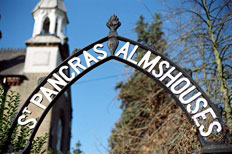Intended as ‘an asylum for decayed and deserving ratepayers of the parish’ the St Pancras Almshouses are the result of typical Victorian charity more than a century and a half ago. In 1850 a group of local philanthropists was called together by Dr. Donald Fraser, the senior churchwarden of St Pancras parish church in London, to ‘save respectable characters from the workhouse’. Dr. Fraser was dismayed that in the workhouse elderly couples were forced to live apart, just when they needed each other most.
The first St Pancras Almshouses were built in the parish just north of Prince of Wales road but it was not long before the coming of the railways swept them away. After a battle over compensation that went to the Lord Justices’ Court – the equivalent of today’s Court of Appeal - a new site was bought (for £1,300) in Southampton road, and the first buildings there went up in 1859. One hundred and fifty years later, in 2009, we celebrated our history and paid tribute to the generous-spirited Victorians who established the charity.
We marked this anniversary year with various events and activities, from an historical exhibition to a specially written play about the building of these almshouses, and from a video with interviews with our residents to a celebration garden party at which the Patron of the Almshouse Association HRH The Prince of Wales was our guest of honour.
Today the St Pancras Almshouses are home to 50 people – some single, some couples - living in one and two-roomed flats. Residents have to be aged at least 55, must have lived in the borough of Camden for ten years or more and be in housing need of some kind. The Almshouses are the responsibility of a Board of Trustees, and a small management team maintains the buildings and helps residents live independent lives.
Recently it has become possible to apply for a grant to the Homes and Communities Agency to help pay for improvements that will make the Almshouses fit for the next thirty years. The challenge now is to preserve the architectural integrity of the Grade II listed Victorian buildings while observing modern space and safety standards, and to produce accommodation which will suit the residents of today as well as those to come.
Richard Lindley
Chairman
